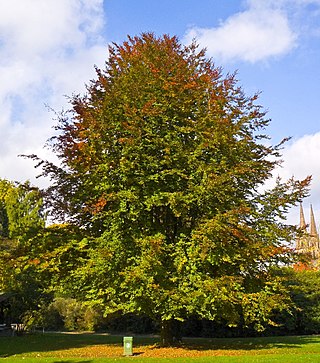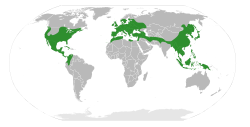Top Qs
Timeline
Chat
Perspective
Fagaceae
Family of flowering plants From Wikipedia, the free encyclopedia
Remove ads
The Fagaceae (/fəˈɡeɪsi.iː, -ˌaɪ/; from Latin fagus 'beech tree') are a family of flowering plants that includes beeches, chestnuts and oaks, and comprises eight genera with around 1,000 or more species.[2][3][4] Fagaceae in temperate regions are mostly deciduous, whereas in the tropics, many species occur as evergreen trees and shrubs. They are characterized by alternate simple leaves with pinnate venation, unisexual flowers in the form of catkins, and fruit in the form of cup-like (cupule) nuts. Their leaves are often lobed, and both petioles and stipules are generally present. Their fruits lack endosperm and lie in a scaly or spiny husk that may or may not enclose the entire nut, which may consist of one to seven seeds. In the oaks, genus Quercus, the fruit is a non-valved nut (usually containing one seed) called an acorn. The husk of the acorn in most oaks only forms a cup in which the nut sits. Other members of the family have fully enclosed nuts. Fagaceae is one of the most ecologically important woody plant families in the Northern Hemisphere, as oaks form the backbone of temperate forest in North America, Europe, and Asia, and are one of the most significant sources of wildlife food.
Several members of the Fagaceae have important economic uses. Many species of oak, chestnut, and beech (genera Quercus, Castanea, and Fagus, respectively) are commonly used as timber for floors, furniture, cabinets, and wine barrels. Cork for stopping wine bottles and a myriad other uses is made from the bark of cork oak, Quercus suber. Chestnuts are the fruits from species of the genus Castanea. Numerous species from several genera are prominent ornamentals. Wood chips from the genus Fagus are often used in flavoring beers. Nuts of some species in the Asian tropical genera Castanopsis and Lithocarpus are edible and often used as ornamentals.
Remove ads
Classification
The Fagaceae are often divided into five or six subfamilies and are generally accepted to include 8 (to 10) genera (listed below). Monophyly of the Fagaceae is strongly supported by both morphological (especially fruit morphology) and molecular data.[5]
The Southern Hemisphere genus Nothofagus, commonly the southern beeches, was historically placed in the Fagaceae as sister to the genus Fagus,[6] but recent molecular evidence suggests otherwise. While Nothofagus shares a number of common characteristics with the Fagaceae, such as cupule fruit structure, it differs significantly in a number of ways, including distinct stipule and pollen morphology, as well as having a different number of chromosomes.[7] The currently accepted view by systematic botanists is that Nothofagus should be placed in its own family, Nothofagaceae.[5]
Remove ads
Subfamilies and genera
Summarize
Perspective
There are two subfamilies:
Fagoideae
Auth. K. Koch. Monotypic
- Fagus L.—beeches; about 10 to 13 species, north temperate east Asia, southwest Asia, Europe, eastern North America
The genus Nothofagus (southern beeches: from the Southern Hemisphere), formerly included in the Fagaceae, is now treated in the separate monotypic family Nothofagaceae.[8]
Quercoideae
Auth. Õrsted
- Castanea Mill. 1754—chestnuts; eight species, north temperate east Asia, southwest Asia, southeast Europe, eastern North America
- Castanopsis (D. Don) Spach 1841—chinquapins or chinkapins; about 125–130 species, southeast Asia
- Chrysolepis Hjelmq. 1948—golden chinkapins; two species, western United States
- Lithocarpus Blume 1826—stone oaks; about 330–340 species, warm temperate to tropical Asia
- Notholithocarpus P. S. Manos, C. H. Cannon & S.H. Oh 2008 [2009]—Tanoaks; 1 species (formerly Lithocarpus densiflorus), endemic to California and southwest Oregon
- Quercus L. 1753—oaks; about 600 species, widespread Northern Hemisphere, crossing the equator in Indonesia
- Trigonobalanus Forman 1962—three species, tropical southeast Asia, Northern South America (Colombia) (three species of Colombobalanus and Formanodendron are included)
The Quercus subgenus Cyclobalanopsis is treated as a distinct genus by the , but as a section or subgenus by most taxonomists.[citation needed]
Remove ads
Distribution
The Fagaceae are widely distributed across the Northern Hemisphere. Genus-level diversity is concentrated in Southeast Asia,[9] where most of the extant genera are thought to have evolved before migrating to Europe and North America (via the Bering Land Bridge).[10] Members of the Fagaceae (such as Fagus grandifolia, Castanea dentata and Quercus alba in the Northeastern United States, or Fagus sylvatica, Quercus robur and Q. petraea in Europe) are often ecologically dominant in northern temperate forests. More than 400 species of Fagaceae, mostly Castanopsis and Lithocarpus, grow in Southeast Asia, with some species in similar dominant roles over large areas.[11]
Phylogeny
Modern molecular phylogenetics suggest the following relationships:[12][13]
Remove ads
References
External links
Wikiwand - on
Seamless Wikipedia browsing. On steroids.
Remove ads


